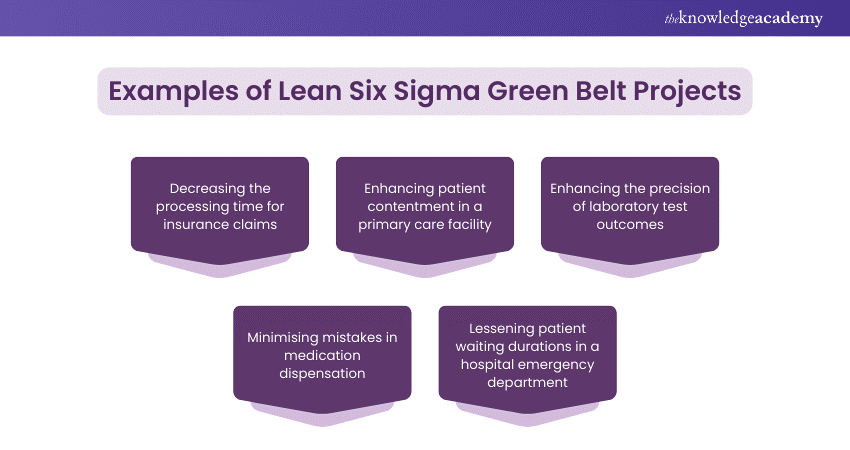We may not have the course you’re looking for. If you enquire or give us a call on +1 6474932992 and speak to our training experts, we may still be able to help with your training requirements.
Training Outcomes Within Your Budget!
We ensure quality, budget-alignment, and timely delivery by our expert instructors.

In process improvement methodologies, Lean Six Sigma is a potent approach aimed at enhancing efficiency and reducing defects in processes across various industries. Among its practitioners are individuals designated as Green Belts, who possess a fundamental understanding of Lean Six Sigma principles and tools. In this blog, we delve into the essence of Lean Six Sigma Green Belt Project Examples, elucidating their significance and offering detailed examples to illustrate their applications
Table of Contents
1) What is Lean Six Sigma Green Belt Project?
2) Examples of Lean Six Sigma Green Belt Projects
a) Decreasing the processing time for insurance claims
b) Enhancing patient contentment in a primary care facility
c) Improving the precision of laboratory test outcomes
d) Minimising errors in medication dispensation
e) Reducing patient waiting times in a hospital Emergency Department
3) Conclusion
What is Lean Six Sigma Green Belt Project?
The Lean Six Sigma Green Belt Projects are the focus of companies whose purpose is to improve the way the processes are conducted. The Green Belt projects, which follow the principles of the Lean manufacturing and the Six Sigma methodologies, are exhaustively detailed initiatives that are undertaken by individuals with an in-depth comprehension of these methodologies – the Green Belts.
Lean Six Sigma Green Belt projects are carefully planned and implemented unitary tasks that are targeted at the improvement of the organisational procedures. Each of these projects is characterised by its own agenda, was data-driven and the goal was to bring results. The local Green Belts, usually mid-level employees, run the projects while the upper-level Black Belts or Master Black Belts take on the role of supplying guidance and support.
Green Belt projects typically follow the DMAIC (Define, Measure, Analyse, Improve, Control) framework:
1) Define: Tackle the problem or need, set clear objectives and define the scope of a project from its formulation.
2) Measure: Collect data which can be used to identify baseline performance metrics as well as characteristics of the current process functioning.
3) Analyse: Study the data to pinpoint the source of workflow issues and inefficiencies.
4) Improve: Create and apply solutions tackling the root causes of the problems found and improve the process performance.
5) Control: By setting in place control systems and measures to sustain the positive results and not allow for any relapse.
The Green Belt utilises different Lean and Six Sigma toolsets and methods in the different stages of project development. An instance of these is process mapping, value stream mapping, root cause analysis, also statistical process control, regression analysis and so on.
In essence, Lean Six Sigma Green Belt projects serve as catalysts for continuous improvement within organisations, fostering a culture of problem-solving, data-driven decision-making, and operational excellence. By empowering individuals with the skills and methodologies to identify and address inefficiencies, Green Belt projects contribute to enhanced customer satisfaction, increased productivity, and sustainable business growth.
Examples of Lean Six Sigma Green Belt Projects

1) Decreasing the processing time for insurance claims
The timely processing of claims is a fundamental part of insurance in the aspect of assuring customer satisfaction and helping the operations go smoothly. With long processing time, not only customers get irritated, but also company’s resources get strained, and the performance of the company suffers. The implementation of Green Belt project for the reduction of processing time of insurance claims in Lean Six Sigma is an enterprise’s strategic move that will put the entire claims workflow in order, from the initial submission to the final closure.
1) Define: Collaborating with stakeholders to set clear objectives for reducing processing time while maintaining accuracy.
2) Measure: Analysing data on processing times and bottlenecks to establish a baseline for improvement.
3) Analyse: Identifying root causes of delays, such as manual errors or inefficient workflows.
4) Improve: Implementing solutions like automation, standardisation, and improved communication to streamline processes.
5) Control: Establishing monitoring mechanisms and performance metrics to sustain improvements over time.
Through targeted efforts led by Green Belts, insurance companies can significantly enhance efficiency, reduce processing time, and elevate customer satisfaction, ensuring a competitive edge in the industry.
Improve your Lean Six Sigma skills through our Lean Six Sigma Green Belt Course.
2) Enhancing patient contentment in a primary care facility
Ensuring patient satisfaction is paramount in delivering quality healthcare services. A Lean Six Sigma Green Belt project focused on enhancing patient contentment in a primary care facility involves a strategic approach:
1) Define: Collaborating with stakeholders to identify key satisfaction factors, such as wait times and communication.
2) Measure: Collecting data through surveys and observation to quantify current satisfaction levels.
3) Analyse: Identifying root causes of dissatisfaction, like long wait times or communication gaps.
4) Improve: Implementing targeted interventions, such as scheduling improvements and enhanced communication protocols.
5) Control: Establishing monitoring mechanisms for sustained improvements, including ongoing feedback and performance metrics.
Through these focused efforts led by Green Belts, primary care facilities can elevate patient satisfaction, foster patient loyalty, and improve overall healthcare outcomes.
3) Enhancing the precision of laboratory test outcomes
Achieving accurate laboratory test outcomes is crucial for effective medical diagnosis and treatment. A Lean Six Sigma Green Belt project aimed at enhancing the precision of laboratory test outcomes follows a meticulous approach:
1) Define: Stakeholders collaborate to identify areas needing precision improvement and set clear objectives.
2) Measure: Data analysis is used to assess current precision levels and identify any discrepancies.
3) Analyse: Root causes of inaccuracies, such as equipment calibration issues or procedural errors, are identified.
4) Improve: Targeted solutions, like recalibrating equipment or enhancing training, are implemented to address root causes.
5) Control: Robust mechanisms are established to sustain improvements, including ongoing monitoring and maintenance.
By prioritising precision and implementing systematic improvements, laboratory facilities can enhance the reliability of test outcomes, leading to more accurate diagnoses, improved patient care, and enhanced overall healthcare quality. Through the leadership of Green Belts, these initiatives drive positive change and contribute to the continuous improvement of laboratory operations.
Improve your Lean Six Sigma skills through our Lean Six Sigma Black Belt Upgrade Course.
4) Minimising mistakes in medication dispensation
Reducing errors in medication dispensation is critical for patient safety and quality healthcare delivery. A Lean Six Sigma Green Belt project targeting this issue employs a systematic approach:
1) Define: Collaborating with healthcare professionals to outline the significance of error reduction and pinpoint specific areas for improvement in medication dispensation processes.
2) Measure: Utilising data analysis methods to quantify the frequency and types of medication errors occurring during dispensation, establishing a baseline for improvement.
3) Analyse: Conducting a thorough analysis to identify the root causes of medication dispensation errors, such as communication breakdowns, inadequate training, or system deficiencies.
4) Improve: Implementing targeted interventions to address identified root causes, which may include enhancing communication protocols, providing additional training to staff, implementing barcode scanning systems, or redesigning medication dispensation workflows.
5) Control: Establishing robust control measures to sustain improvements, including ongoing monitoring of medication error rates, regular staff training, and continuous process evaluations.
By prioritising patient safety and implementing systematic improvements, healthcare facilities can minimise medication errors, enhance patient outcomes, and improve overall healthcare quality. Led by Green Belts, these initiatives drive positive change and contribute to a culture of safety and excellence in medication dispensation practices.
5) Lessening patient waiting durations in a hospital Emergency Department
The cutting down of patient's waiting times in a hospital Emergency Department (ED) is paramount to ensure patients receive their medical treatment on time. A Lean Six Sigma Green Belt project addressing this challenge follows a structured approach:
1) Define: Collaboration with ED staff to establish clear goals for reducing waiting times and enhancing patient care.
2) Measure: Analysis of data to quantify current waiting times and identify bottlenecks in the ED workflow.
3) Analyse: Identifying root causes of prolonged waiting times, such as inefficient triage processes or staffing shortages.
4) Improve: Implementing targeted solutions, including streamlined triage protocols and optimised staffing levels, to expedite patient flow.
5) Control: Establishing monitoring mechanisms to sustain improvements, including regular tracking of waiting times and ongoing process evaluations.
Through these focused efforts led by Green Belts, hospitals can significantly reduce patient waiting times in the ED, improving patient satisfaction and overall healthcare outcomes.
Conclusion
Lean Six Sigma Green Belt Project Examples are potent drivers of operational excellence. From healthcare to insurance, these initiatives streamline processes, enhance quality, and elevate customer satisfaction. Led by Green Belts, they epitomise efficiency, innovation, and continuous improvement, positioning organisations for sustained success in today's dynamic market.
Improve your Lean Six Sigma skills through our Lean Six Sigma Yellow Belt Course.
Frequently Asked Questions

An example of a Green Belt project in Six Sigma is reducing defects or cycle time in a manufacturing process. This involves identifying root causes of errors, implementing improvements, and monitoring performance to sustain gains.

The duration of a Green Belt project in Six Sigma varies but typically ranges from three to six months. However, it depends on project complexity and resource availability.

The Knowledge Academy takes global learning to new heights, offering over 30,000 online courses across 490+ locations in 220 countries. This expansive reach ensures accessibility and convenience for learners worldwide.
Alongside our diverse Online Course Catalogue, encompassing 17 major categories, we go the extra mile by providing a plethora of free educational Online Resources like News updates, Blogs, videos, webinars, and interview questions. Tailoring learning experiences further, professionals can maximise value with customisable Course Bundles of TKA.

The Knowledge Academy’s Knowledge Pass, a prepaid voucher, adds another layer of flexibility, allowing course bookings over a 12-month period. Join us on a journey where education knows no bounds.

The Knowledge Academy offers various Lean Six Sigma Certification Training, including Lean Six Sigma Green Belt Course, Lean Six Sigma Yellow Belt Course and Lean Six Sigma Black Belt Course. These courses cater to different skill levels, providing comprehensive insights into How to Apply Lean Six Sigma? A Step-by-Step Guide
Our Business Improvement Blogs covers a range of topics offering valuable resources, best practices, and industry insights. Whether you are a beginner or looking to advance your skills, The Knowledge Academy's diverse courses and informative blogs have you covered.
Upcoming Business Improvement Resources Batches & Dates
Date
 Lean Six Sigma Green Belt
Lean Six Sigma Green Belt
Mon 3rd Jun 2024
Mon 8th Jul 2024
Mon 5th Aug 2024
Mon 9th Sep 2024
Mon 7th Oct 2024
Mon 4th Nov 2024
Mon 2nd Dec 2024







 Top Rated Course
Top Rated Course



 If you wish to make any changes to your course, please
If you wish to make any changes to your course, please


